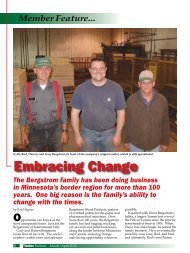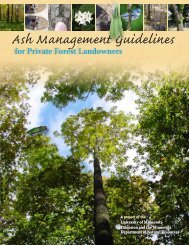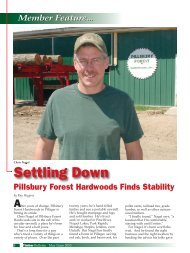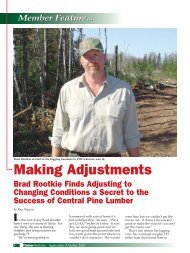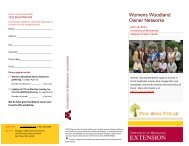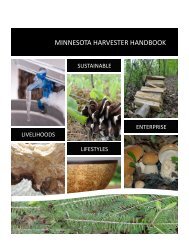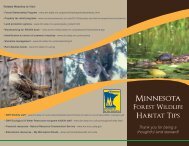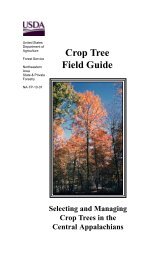Ash Management Guide for Private Forest Landowners
Ash Management Guide for Private Forest Landowners
Ash Management Guide for Private Forest Landowners
Create successful ePaper yourself
Turn your PDF publications into a flip-book with our unique Google optimized e-Paper software.
Chapter 4The Emerald<strong>Ash</strong> BorerWhat About the Cold?Scientists are still studying EAB’swinter survival in northern Minnesota.People with significant amounts of ashshould not dismiss the threat of EAB,regardless of where their stand is located.However, data from 2009-2010 field seasonshows evidence that winter survivalof EAB is poorer in northern areas, andSurvey Recommendations aboutEAB cold hardinessMore research is needed on the hardiness of EAB; however there is enoughuncertainty that landowners should know EAB may spread more slowly innorthern MN. Based on preliminary research, EAB survival in northern Minnesotawill be lower than in southern Minnesota and will likely reduce populationbuildup and spread of EAB. One genetics expert pointed out, “Thereis evidence to suggest that winter survival of EAB in northern MN could beexpected to be lower than in southern MN. That says nothing about how lowersurvival rates may impact spread of the adults.” “Natural spread is not the primary(or sole) issue of concern.” Also according to a silviculturalist, “It’s alwaystrue that bugs reproduce less in colder areas, but EAB lives in some areasin China that are much colder than MN (even northern MN), and some fairlymild areas. However, the bug might be able to undergo selection <strong>for</strong> cold tolerancein several generations, and climate change might also come into play.”<strong>Ash</strong> management recommendations should be based on the distance toa known EAB infestation. One word of caution from a harvesting expert is“please consider proximity to major roads of people moving in from EAB occupiedzones. And hardiness in<strong>for</strong>mation as it becomes more available fromplaces like Michigan.” One entomologist also pointed out that shifting climatepatterns may alter EAB spread <strong>for</strong> various locations throughout the state. Ifmanagement zones are desired, create them based on proximity to known EABlocations and likely next occurrences. Thoughts from another entomologist are,“the distance to a known EAB infestation and hardiness zone in<strong>for</strong>mation rightnow should only affect the urgency <strong>for</strong> doing something, not the types of managementrecommendations. Hardiness of EAB in northern Minnesota shouldonly influence the urgency of doing something not what is actually done.”In addition to hardiness, research about EAB and black ash may also affectfuture management recommendations. An important point to remember thatis because EAB is a relatively new exotic pest our knowledge of the insectand our management or control recommendations will change over time, andsometimes this may change quite rapidly.” Another comment from an entomologist,“I am also somewhat reluctant because we were told that Dutch elm diseasewouldn’t be a problem in northern Minnesota and that gypsy moth wouldnot be as much of a problem in northern Minnesota as in southern Minnesota.Insects and diseases have a way of surprising us.” Another recommendationfrom the panel of experts is that ash management recommendations shouldbe based on both distance from a known EAB infestation AND hardiness zonein<strong>for</strong>mation.26



